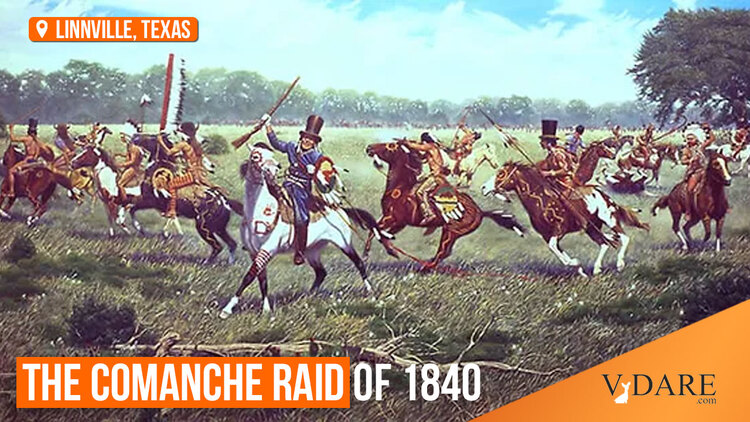
The Comanches’ Great Raid of 1840
10/11/2023

With raids on civilians and hostage-taking back in the news, I looked up the Comanches’ Great Raid of 1840 that destroyed forever the Texas port city of Linnville, about halfway between Houston and Corpus Christi.
As with many ethnic conflicts, who were the bad guys and who were the good guys tends to flip-flop depending upon how far back in the chain of retaliatory counter-atrocities you go to start the narrative. Do you start your tale with X -> Y, or previously with Y -> X -> Y, or even further back with X -> Y -> X -> Y, etc.
The immediate predecessor event to the Comanches’ Great Raid was the Council House Fight in San Antonio. The Texians demanded a parley to arrange for getting back 16 white hostages from the Indians. But the Comanches only showed up with one, a young girl.
The Texians didn’t grasp that the fearsome Comanches were not a unified nation but more like a dozen or more motorcycle gangs on the make, with just a few represented at the council to see what the going price for a hostage was. The Texians then announced that, turnabout being fair play, they were taking the Comanche chiefs at the parley hostage. This shocked the Comanches’ sense of morality. They tried to fight their way out of captivity and two or three dozen were killed in the fight.
In response, the Comanches then tortured to death 13 white hostages. A chief named Buffalo Hump, who hadn’t attended, announced he would lead a great raid on the white man’s cities as vengeance. He assembled 500 or more braves in north central Texas and led them south toward the Gulf of Mexico hundreds of miles away. In the Indian wars, the Native Americans tended to be far more politically fractured, so it took an impressive leader to assemble that large a force in one place.
They first attacked the inland town of Victoria about 125 miles southwest of Houston, killing a dozen locals. But the heavily armed Texian civilians fired out from inside their buildings and eventually the Comanches rode on to the busy port of Linnville, killing maybe another dozen civilians. The remainder, realizing Plains Indians had no familiarity with open water, piled into boats and escaped into the ocean, where they bobbed up and down watching their town be sacked.
After a day of drunken revels, the Comanches, wearing top hats and loading other loot onto pack mules, headed home with their 3,000 stolen horses, burning Linnville to the ground. Normally, the Texas Rangers could never catch the hard riding Comanches, but this time their pack mules slowed them down. The Rangers managed to kill a few dozen Comanche, but when some of the Indians jettisoned their stolen gold bullion to make a faster escape, the Rangers stopped pursuing in order to divvy up the gold amongst themselves.
Linnville was never rebuilt.
Although the death toll from the Great Raid was not immense, the Comanche wars went on for another 35 years. During the Civil War, many veteran Confederate and Union troops remained at their posts in the west guarding against the Comanches and other Plains Indians, missing out on the glory. But that suggests how much Americans, north and south, feared the potential of the mounted warriors of the plains.
